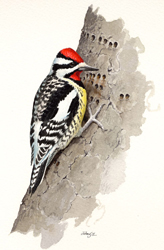Find a Bird - BBA1
Breeding Bird Atlas 1 Species Accounts
Yellow-bellied Sapsucker
Sphyrapicus varius
Egg Dates
May to mid-June (estimated)
Number of Broods
one; may re-lay if first attempt fails.

The mystery of the Yellow-bellied Sapsucker’s rarity during migration remains unchanged over the years. Its scarcity, particularly in spring, is remarkable, for it is a very common resident of the northern woods. As a breeder in Massachusetts, it has continued to increase long after the hill country reverted to forest. The sapsucker was still considered a rare and local summer resident in the higher hills in the mid-1950s and was said to be steadily decreasing. Curiously, in spite of continual lumbering, this species is currently a very common breeding bird in any forest where birch, beech, and maple predominate and oaks do not, at elevations as low as 500 feet but generally above 600 feet. The Berkshires are a stronghold, and east of the Connecticut River the population falls off dramatically, and the birds are surprisingly scarce in appropriate habitat in Worcester County.
The sapsucker arrives on its local breeding grounds from early to mid-April, with migrants continuing to pass until mid-May. At this time, a few can be seen west and north of Boston or in the Connecticut River valley. It occurs rarely in spring in southeastern Massachusetts or on the Cape and Islands but is regular in small numbers there in the fall. Migrants favor orchards, suburban groves, and cemeteries because the birds seem to avoid the natural oak forests of these lowland regions. In their native hills, they are attracted to Beaver swamps and other wetlands but can be found as well on steep hillsides. They prefer more open woods, such as those recently lumbered.
The common call note heard on the breeding territory, and occasionally on migration, is an emphatic, prolonged squeal or mewing note, repeated several times. It is fairly high-pitched and slightly burry. The sapsucker is a noisy bird at breeding time and has a number of less common calls, some resembling those of the Blue Jay or Red-shouldered Hawk. A variety of low sounds are made in the vicinity of the nest and mate. Both sexes drum, giving a short roll followed by several distinct measured taps, slower toward the end. These are often repeated, with distant males responding to each other.
A nesting pair generally chisels a cavity out of a dead or dying tree but may select a live one, taking care to leave the access hole as small as possible. It may take a week or more to complete the gourd-shaped excavation, which averages 10 to 14 inches deep and is located 8 to 40 feet above the ground. Birch and aspen are preferred tree species. Three Massachusetts nests from the Huntington-Chester area were located as follows: 1 at 20 feet in a dead ash, 1 at 24 feet in a dead snag, and 1 at 25 feet in a dead White Pine (Blodget). A nest in Warwick was situated at a height of 9 feet (Coyle). Surprisingly little has been recorded about the nesting habits of this species in Massachusetts. From what is known about spring arrival dates and nestling and fledgling dates, it appears that nests with eggs can be found from May into June. The four to seven white eggs are incubated for about 14 days in typical woodpecker fashion by both sexes, with the male on duty at night. The young birds remain in the nest for 26 to 29 days and hiss loudly when disturbed. The parents are kept busy feeding the hungry mouths, bringing sap, insects, and small fruits. Sapsuckers are perhaps among the most active members of the woodpecker family, constantly flitting from tree to tree and gleaning insects from both bark and foliage.
Nestling dates in Massachusetts have been recorded from late May to early July (TC, Meservey). A pair in Blandford was observed feeding nestlings on June 12. Most reports of fledglings are from late June into July, with a late date of an adult and three young on August 5 (TC). The young remain with the parents and receive some food until they are at least 38 days old. One brood is raised each year.
The name sapsucker comes from the birds’ penchant for drilling a series of small holes in sap-bearing trees and feeding regularly on the flow from the openings. They may use several trees close together in this way, creating a favorite “orchard,” which they visit constantly. Insects, captured at the holes or elsewhere, may be dipped in the sap before being consumed or fed to the young. Besides insects, a variety of mammals and birds, including the Ruby-throated Hummingbird, join in the repast. A large variety of trees may be drilled, but very few are permanently injured by this habit.
By summer’s end, the families break up and the birds are molting (see Red-headed Woodpecker account). Sapsuckers slip away to the south starting in September, with migrants showing up in the lowlands late in the month and into October. They seem to be as quiet and surreptitious in this season as they are noisy and energetic when nesting. Unlike our other migratory woodpecker, the flicker, this species does not travel in flocks, although two or three might be found together. By November, most have gone south, but occasional individuals are found during the winter, and these may sometimes survive in mild seasons. Yellow-bellied Sapsuckers winter from the southern United States south through Central America to central Panama and on some of the Caribbean Islands.
Map Legend and Data Summary
Atlas 1 data collected from 1975-1979


Note: fairly common in the hills of Berkshire County; decreasing eastward; absent east of Worcester County
Seth Kellogg



